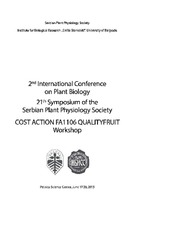Приказ основних података о документу
Changes in polyphenols content in soybean and Datura stramonium after treatment with herbicides and Delfan Plus
| dc.contributor | Uzelac, Branka | |
| dc.contributor | Šiler, Branislav | |
| dc.creator | Malenčić, Djordje | |
| dc.creator | Kiprovski, Biljana | |
| dc.creator | Prvulović, Dejan | |
| dc.creator | Rajković, Miloš | |
| dc.creator | Malidža, Goran | |
| dc.date.accessioned | 2021-10-28T10:54:02Z | |
| dc.date.available | 2021-10-28T10:54:02Z | |
| dc.date.issued | 2015 | |
| dc.identifier.isbn | 978-86-912591-3-6 (SPPS) | |
| dc.identifier.uri | http://fiver.ifvcns.rs/handle/123456789/2322 | |
| dc.description.abstract | The most common herbicide combination for weed prevention in soybean is Pulsar 40 and Harmony 75WG, but when applied during hot days these herbicides may induce oxidative stress in plants. Delfan Plus® is a biostimulator with high amino acid content which can be used in combination with herbicides. Manufacturer advertises it as a supplement for faster protein synthesis and thus, overcoming stress conditions caused by high and low temperatures, drought, herbicides etc. In order to investigate the ability of Delfan Plus® to mitigate the effect of herbicides on soybean plants (and its weed species Datura stramonium L.), we analyzed the accumulation of polyphenolic compounds (total polyphenols, tannins, flavonoids and proanthocyanidins), as well as phytotoxicity and grain yield. In addition, we determined the antioxidant capacity of plant extracts in DPPH and NBT-tests. Soybean cultivar Sava was treated with Pulsar 40 + Harmony 75WG (1 L ha-1 + 8 g ha-1 and 2 L ha-1 + 16 g ha-1, respectively), with or without Delfan Plus® (1 L ha-1 and 2 L ha-1, respectively). Biochemical parameters analyzed showed that Delfan plus® did not decrease the level of stress in plants. Most parameters increased their values 7 days after the treatment, compared to day 1, which was expected. Specimens of D. stramonium were especially stressed after herbicide treatment. Although soybean yield was somewhat higher after the treatment with normal dose of herbicides and Delfan plus® (3.28 t ha-1), there were no statistical differences between the treatments. Hence, the question of the application of this biostimulator in agronomic practice may be raised. | sr |
| dc.language.iso | en | sr |
| dc.publisher | Belgrade: Serbian Plant Physiology Society | sr |
| dc.publisher | Belgrade: University of Belgrade, Institute for Biological Research „Siniša Stanković“ | sr |
| dc.relation | info:eu-repo/grantAgreement/MESTD/Technological Development (TD or TR)/31022/RS// | sr |
| dc.rights | openAccess | sr |
| dc.rights.uri | https://creativecommons.org/licenses/by/4.0/ | |
| dc.source | Book of Abstracts, 2nd International Conference on Plant Biology, 21st Symposium of the Serbian Plant Physiology Society, 17-20.06.2015, Petnica Science Center, Serbia | sr |
| dc.subject | soybean | sr |
| dc.subject | abiotic stress | sr |
| dc.subject | polyphenols | sr |
| dc.subject | phenolics | sr |
| dc.subject | herbicides | sr |
| dc.subject | biostimulators | sr |
| dc.subject | antioxidants | sr |
| dc.subject | antioxidant capacity | sr |
| dc.title | Changes in polyphenols content in soybean and Datura stramonium after treatment with herbicides and Delfan Plus | sr |
| dc.type | conferenceObject | sr |
| dc.rights.license | BY | sr |
| dc.citation.epage | 173 | |
| dc.citation.spage | 172 | |
| dc.identifier.fulltext | http://fiver.ifvcns.rs/bitstream/id/6288/bitstream_6288.pdf | |
| dc.identifier.rcub | https://hdl.handle.net/21.15107/rcub_fiver_2322 | |
| dc.type.version | publishedVersion | sr |


